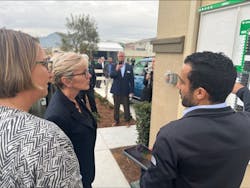California Dream Comes True: New Microgrid Community Attracts DOE Secretary Visit
A new neighborhood in southern California welcomed an important visitor from the nation’s capital this week who came to champion the community’s commitment to microgrid and clean energy technologies.
U.S. Department of Energy (DOE) Secretary Jennifer Granholm visited the city of Menifee on Monday to witness first-hand what some are calling the state of the art in sustainable, power-resilient neighborhoods in the Durango and Oak Shade communities.
Residential builder KB Home led construction of more than 200 all-electric homes powered by solar, battery storage and a connection to a microgrid centered around a large, community battery.
“These communities will work as decentralized energy resources that can act as part of a virtual power plant and create a self-reliant, energy-efficient neighborhood independently powered through solar and storage,” Rob McGibney, president and COO of KB Home, said in a statement. “I was personally excited to take Secretary Granholm on a tour of these KB homes as these microgrid communities will also serve as a working laboratory over the next few years to help us explore and guide how the future may be powered.”
Those partnering with KB Home in the “Connected Communities” project include Schneider Electric, project lead SunPower, electric utility Southern California Edison (SCE) and the energy research group at the University of California-Irvine (UCI). Menifee is located in Riverside County.
The trip to visit the KB Home community microgrid site was one of several stops Secretary Granholm made in California to highlight the Biden administration’s work in supporting clean energy initiatives in neighborhoods and communities.
Jana Gerber, microgrid president at Schneider Electric North America, welcomed Granholm and shared with her the partnership’s excitement over a fully carbon-neutral, stand-alone and bidirectional energy community of the future. The Menifee project also benefits from a $6.65 million DOE grant and renewables funding from the Inflation Reduction Act (IRA).
“Secretary Granholm witnessed the home and community of the future, which has the ability to go off-grid with microgrid and vehicle-to-home power,” Gerber said. “As I shared with her during the visit, this is a revolution for energy independence across America, and IRA credits help us get there. I say deploy, deploy, deploy as this is a win for the public and private sectors.”
Each of the homes is or will be powered by SunPower Equinox solar systems and 13-kWh SunVault Storage batteries, while also connected to the microgrid controls centered around the community battery. California, due to the wildfire dangers, is prone to grid outages and utility-initiated public safety power shutoffs when wind and fire risks are high.
Multi-Customer Microgrids Focus of Session at Microgrid 2024
Happening April 22-24 in Baltimore at Marriott Waterfront
Early Bird Registration Still Available: Save $365
Energy efficiency is another key to the Connected Communities initiative, as the Durango and Oak Shade residences all meeting EnergyStar, WaterSense and Indoor airPLUS criteria. High efficiency appliances and electric heat pump water heaters and heating, venting and air conditioning systems are being installed in each of the homes.
They are also being pre-wired to accommodate smart electric vehicle (EV) chargers with some having bidirectional capabilities. EV chargers will be available for purchase at the time of the home sales, according to the developer.
The distributed energy resource capabilities allow home residents to enroll in a virtual power plant (VPP) program in which aggregated battery storage, EV chargers and other flexible loads can be dispatched to provide grid support during times of heavy demand. Enrolled residents can be compensated for the VPP and grid services participation.
The KB Home project really began when the builder joined forces with solar equipment supplier SunPower and UCI to envision a new and “zero energy” home community. The DOE grant helped fund the distributed energy resource deployments in the Durango and Oak Shade neighborhoods, while Schneider Electric handled microgrid design and engineering support.
SCE participated to ensure the interconnection work was handled safely. The utility will work with UCI’s Advanced Power and Energy Program to study the effectiveness of the VPP program in supporting grid infrastructure.
Track news on community microgrids with our free Microgrid Knowledge newsletter









